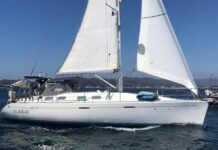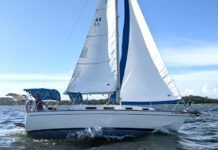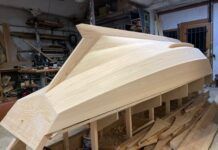Space is tight on your pedestal or cockpit bulkhead, and so is your budget. But spring is here, and you want a taste of the latest and greatest in electronics. A chartplotter-sounder combo might be the solution—one with all the best features, like an LCD color screen, an alphanumeric keypad, a WAAS-enabled GPS receiver, and a powerful sounder. Good news: We found a pair that won’t break the bank.

What We Tested
Two major players in the marine electronics field, Furuno and Simrad, each supplied us with a chartplotter/sounder combination unit. The Furuno GP-1850WF and the Simrad CE33 have all the features we sought, and are capable of using cartography from a card. Navionics supplied a South Florida map-card for the Furuno unit, and C-Map loaned us one for the Simrad.
How We Tested
Daytime screen visibility has been a major benchmark rating in all of our tests of screen-equipped electronics, and it remains so here. If you can’t see the screen well, it doesn’t matter how much or how great the information in the machine might be.
The units were rated for daylight viewing by temporarily installing them on a test powerboat, going to sea, and using them on a bright sunny day. We looked at each screen from various angles, with and without polarized sunglasses, using several different background color palettes, and from various sun angles. Our night view rating was done in a shop under dark conditions with no artificial lighting.
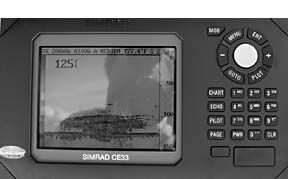
As in previous on-water tests, we passed over known bottom structures to evaluate the sounders. This time, we used the same transducer to test both units—an Airmar B44 10-pin through-hull tri-ducer installed on the test boat. We used an Airmar-supplied crossover cable to attach the 10-pin connector to the 7-pin Simrad CE33. The transducer’s 10-pin connector is designed for certain Furuno units, so it connected to the Furuno GP-1850 without the need for a crossover cable.
Each unit’s sounder was rated in shallow water by cruising a channel with depths ranging from 10 to 20 feet, as well as idling up a hard rock ledge that terminates in near-shore waters averaging three feet deep. The channel contains several pieces of hard bottom structure that helped the evaluation. For deep-water testing, we rated the sounders by making several passes over a steel wreck in 125 feet of water.
All sounder testing was done in 75-degree salt water. We did not test these sounders out to their maximum effective depth, which we would expect to be over 1,000 feet of water.
Plotters were rated for user interface based on each unit’s pushbuttons, cursor pad, and software. The easier and more intuitive a unit, the higher the rating. Each unit was supplied with a GPS antenna, which we used during both shop and sea testing.
Furuno GP-1850
The latest incarnation of the Furuno GP-1850, which originally hit the market in 1998, is available in four versions—two with sounder capability, the WF and WDF, and two without, the W and WD. All have integral 12-channel WAAS GPS receivers. D versions also contain a differential GPS receiver. F versions include a 600-watt integrated sounder. Screens have been upgraded as well in all newer versions, with an anti-reflective coating to improve daylight viewing. Furuno supplies all of the 1850 series electronics with a plastic mounting bracket. Flush mounting is an option.
Our test unit, a GP-1850 WF, is the best-selling of the four newer versions. It’s a bit bulkier than the Simrad CE33. Front faceplate measurements are 10-1/8″ by 6-1/2″, with a case depth of 5-1/2″. The landscape color screen measures 6-1/2″ on the diagonal, and is equipped with eight brightness levels plus adjustable tone control.
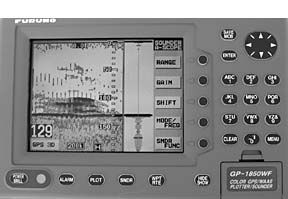
We found the screen easy to see in daylight when viewed without sunglasses. It darkens slightly when viewed with polarized sunglasses and blanks completely when viewed at more than a 45-degree angle. Some minor reflectivity is also evident. Overall, we rate daylight viewing as Good. Night viewing is also Good. The only downside we found during night operations was somewhat uneven backlighting in the pushbuttons. Background colors can be set separately for both the plotter or sounder mode.
Waypoint storage capacity is 800 points, less than a tenth of the Simrad’s 10,000-waypoint storage capability. The numbers continue in this fashion for route storage: Furuno 200, Simrad 1,000.
At PS, we don’t consider the number of available waypoints and routes a significant rating factor, at least when those numbers rise above what any navigator could conceivably use them for. Furuno spokesman Jeff Kauzlaric amplifies this point: “We have found through an informal survey of our customers that about 98% of them use less than 500 waypoints on their plotters. In fact, the majority of them use less than 200 waypoints. As with any electronic product, every feature utilizes system memory. We have limited the waypoints to 800 and utilized that extra memory for other features such as our user interface.”
More important is the maximum number of characters allowed in a waypoint name. Furuno allows only 6, while Simrad allows 25. The Furuno, however, can store a 13-character comment with each waypoint.
The GP-1850’s soft keys are well thought-out. The cursor pad and soft keys on any machine can be made to change function with each different displayed screen page. This effectively adds numerous extra control keys to a unit. Furuno software limits the duties of the cursor pad in favor of the soft keys, while Simrad keeps the cursor operational in most modes. This is a significant difference between the 1850 and the CE33.
We like the soft key approach a little better. They are clearly labeled on screen as to their function in each mode of operation, so you don’t need to memorize the functions.
Sounder capabilities of the GP-1850 are comparable to the highly touted Furuno 582L. It is equipped with 600 watts of power and numerous features, including dual frequency capability (50/200 kHz), marker zoom, bottom lock and zoom, A-scope, and shift. Performance was rated Good in both shallow and deep water. Furuno’s standard warranty of two years for parts and one year for labor coverage applies to the GP-1850. We found the WF version at www.pyacht.com for $1,579.95. A bronze through-hull transducer adds $209.95 if you want depth, speed, and temperature. If you only want temperture, it’s $89.95.
Bottom Line: Though the Furuno GP-1850 is bulky compared to the Simrad, its day viewability and price are better. We found the Furuno software easier to learn than the Simrad’s.
Simrad CE33
On the market since May of 2002, the Simrad CE33 has a built-in 14-channel WAAS GPS receiver, chartplotting capability, and a 600-watt sounder. Trimmer than the Furuno, it measures 10″ by 5-5/8″ by only 2-3/4″ depth. Our test unit was equipped with a 5.7″ (diagonal) color screen in landscape layout. Fifteen levels of brightness control are available and keypad brightness is adjusted separately. The unit can be mounted on the supplied metal bracket or flush-mounted. Installation was simple and straightforward.
The CE33 screen is not as easy to see in sunlight as the Furuno. It appears somewhat darker, darkening further when viewed with polarized sunglasses. Like the Furuno, it completely blanks when viewed from more than a 45-degree angle with the polarized glasses. Reflectivity is far higher than the Furuno.
While we were on the water reviewing both units, the middle portion of the Simrad screen fogged up. It was still usable, but certainly an annoyance. We were out for nearly two hours and in that time the screen did not clear. We asked Simrad about the fogging. Said Simrad spokesman John Caballero: “With thousands of 33 series products sold, we have under 100 documented cases of display fogging. In early 2003, Simrad incorporated a GoreTex filter into all 33 series products. That reduced the likelihood of fogging, but unfortunately, rare instances of display fogging could still occur. Fogging incidents are covered by our limited warranty and an exchange unit is issued.”
Good response. We gave the Simrad a Fair rating in the daytime-view department, more for the reflectivity than for the fogging, which presumably would be a one-time problem.
It was a different story at night. The screen and pushbutton backlighting earned an Excellent rating compared to the Furuno’s Good.
Nine color palettes are available: 1 and 2 are designed for bright sunlight, 3 for normal daylight, and 4 for night viewing. We used number 1 for our daytime view ratings and number 4 for night viewing—the color changes do make a difference in viewability.
Though the Simrad has very capable memory hardware, its software is not as intuitive as the Furuno’s, in our opinion. One must read the manual thoroughly to operate the Simrad well.
One strong point of the Simrad software is the context-sensitive cursor pad. For instance, in the echo sounder mode, the cursor is active as the depth range selector and gain control.
After a period of extended use, one should become familiar enough with the idiosyncrasies of the Simrad software to make the user-interface differences between the two machines a non-issue. The active cursor control let us rate the Simrad software Good, even though we found it more difficult to learn than the Furuno.
Simrad’s built-in sounder is rated at 600 watts and features dual frequency capability (50/200 kHz), variable range marker zoom, A-scope, and bottom expansion.
All Simrad CE33 plotter/sounders are equipped to connect to the newly announced SimNet network with only a software upgrade. The price at www.pyacht.com is $1,998. The through-hull transducer adds another $202.65.
Bottom Line: Simrad’s technically advanced CE33 is a good machine. Screen viewability in sunlight could be improved significantly, we think.
Conclusions
There’s no question that the electronics in the recently developed Simrad CE33 are more powerful than the older technology of the Furuno GP-1850, and the package is trimmer. However, one must ask the question—do I really need to store 10,000 waypoints? We don’t think so. You do, however, need to see the display clearly under all conditions. That’s where the difference lies here. The Simrad’s screen was darker than the Furuno in sunlight, and, in our case, foggy. This prompts us to favor the Furuno GP-1850WF.
Contacts
• Furuno, 360/834-9300, www.furuno.com.
• Simrad USA, 425/778-8821, www.simradusa.com.
Also With This Article
“Value Guide: Furuno Vs. Simrad”




